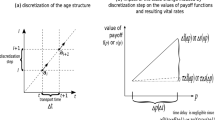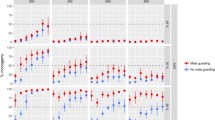Summary
The time-sharing behaviour of dragonfly males (Aeschna cyanea, Odonata) at the mating place is investigated. By computer simulation of the males' interactions the expected number of copulations for different strategies is quantified. The simulation results show that a male's mating succes depends on his strategy and that a strategy's specific pay-off depends on the frequency distribution of strategies in the population. Based on these results, a method for the simulation of the evolutionary process is presented. This approach to evolutionary game theory allows the prediction of evolutionarily stable strategies (ESS), even when the system studied is far too complex for an analytical solution. For the time-sharing behaviour of Ac. cyanea males at the mating place the ESS predicted by the simulation approach complies with field observations.
Similar content being viewed by others
References
Brown RLW (1983) Evolutionary game dynamics in diploid populations. Theor Popul Biol 24:313–322
Corbet PS (1980) Biology of Odonata. Annu Rev Entomol 25:189–217
Davies NB (1978) Biology of Odonata. Annu Rev Entomol 25:189–217
Davies NB (1978) Territorial defence in the speckled wood butterfly (Parage aegeria): the resident always wins. Anim Behav 26:138–147
Kaiser H (1974a) Verhaltensgefüge und Temporialverhalten der Libelle Aeschna cyanea (Odonata). Z Tierpsychol 34:398–429
Kaiser H (1974b) Die Regelung der Individuendichte bei Libellenmännchen (Aeschna cyanea, Odonata). Eine Analyse mit systemtheoretischem Ansatz. Oecologia (Berl) 14:53–74
Kaiser H (1974c) Die tägliche Dauer der Paarungsbereitschaft in Abhängigkeit von der Populationsdichte bei den Männchen der Libelle Aeschna cyanea (Odonata). Oecologia (Berl) 14:375–387
Kaiser H (1976) Quantitative description and simulation of stochastic behaviour in dragonflies (Aeschna cyanea, Odonata). Acta Biotheor 25:163–210
Kaiser H (1979) The dynamics of populations as result of the properties of individual animals. Fortschr Zool 25:109–136
Kaiser H (1985) Availability of receptive females at the mating place and mating chaneces of males in the dragonfly Aeschna cyanea. Behav Ecol Sociobiol (in press)
Kaiser H, Poethke HJ (1984) Analyse und Simulation seines Paarungssystems von Libellen: I. Beobachtungsdaten und Simalatioshmodell. In: Moeller DPF (ed) Systemanalyse biologischer Prozesse. Medizinische Informatik und Statistik Bd 52. Springer, Berlin Heidelberg New York Tokyo, pp 59–64
McArthur RH, Pianka FR (1966) On the optimal use of a patchy environment. Am Nat 100:603–609
Maynard Smith J (1982) Evolution and the theory of games. Cambridge Univ Press, Cambridge
Maynard Smith J, Price GR (1973) The logic of animal conflict. Nature 246:15–18
Neumann J von, Morgenstern O (1953) Theory of games and economic behaviour. Princeton Univ Press, Princeton
Pamilo P (1982) Genetic evolution of sex ratios in eusocial Hymenoptera: allele frequency simulations. Am Nat 119:638–566
Poethke HJ, Kaiser H (1984) Analyse und Simulation eines Paarutgassystems von Libellen: II. Evolutions stabiler Strategien. In: Moeller DP (ed) Systemanalyse biologischer Prozeesse. Medizinische Informatik und Statistik, Bd 52. Springer Berlin Heidelberg New York Tokyo, pp 65–70
Rechenberg I (1973) Evolutionsstrategie-Optimierung technischer Systeme nach Prinzipien der biologischen Evolution. Fromman-Holzboog, Stuttgart
Schuster P, Sigmund K (1981) Coyness, philandering and stable strategies. Anim Behav 29:186–192
Thomas B, Pohley HJ (1982) On a global representation of dynamical characteristics in ESS-models. Bio Systems 15:141–153
Zeeman EC (1981) Dynamics of the evolution of animal conflicts. J Theor Biol 89:249–271
Author information
Authors and Affiliations
Rights and permissions
About this article
Cite this article
Poethke, HJ., Kaiser, H. A simulation approach to evolutionary game theory: the evolution of time-sharing behaviour in a dragonfly mating system. Behav Ecol Sociobiol 18, 155–163 (1985). https://doi.org/10.1007/BF00299044
Received:
Accepted:
Issue Date:
DOI: https://doi.org/10.1007/BF00299044




